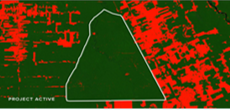MRV Infrastructure

Photo Credit: Image by Freepik
On this page: Find the key concepts on World Bank's ERP, the ERC ecosystem, the different types of crediting programs, and requirements that must be met. Read more below, or visit Strategic Guidance for Country System Assessments, Guidance for Countries in Assessing ERC Projects, or Mobilizing ERC Finance.
Q1: MRV infrastructure: This criterion assesses the project’s closeness to best-practice MRV mechanisms for assuring that key carbon integrity principles are achieved and maintained throughout the lifetime of the project. MRV refers to the multi-step process to measure the amount of greenhouse gas (GHG) emissions reduced by a specific mitigation activity over a period of time, and reporting these findings to an accredited third party, where the third party then verifies the report so that the results can be certified and that resultant ERCs issued are real, measurable, and verified. While the project assessment evaluates the project on its carbon integrity principles, during its actual implementation and operations, the continued upholding of these principles requires strong executional capabilities that will ensure the project’s long-term success and quality. Having these in place will be important for the project’s credibility and to ensure buyer confidence. The following sources and analyses can serve as a guide for the assessment: There are five assessable subcomponents to this criterion, where the project’s mechanisms for the MRV of its carbon assets to generate ERCs are assessed against the guideposts provided in Figure 4.3: Figure 4.3. Guideposts for rating MRV infrastructure Clear and well-defined roles and responsibilities assigned for the operational and management plan for monitoring. Processes for monitoring and coordinating between parties are defined and communicated. A plan or procedure is in place for conservative treatment and/or deduction of ERCs in case of unexpected interruption or error of planned monitoring activities. Roles and responsibilities assigned for operational and management plan for monitoring are in place but could be more clearly defined. Elements of the operational process of monitoring and coordinating between parties are in place but need clearer definition and/or could be more clearly communicated. A plan or procedure is in place for conservative treatment and deduction of ERCs in case of unexpected interruption or error of monitoring activities. Approaches related to the use of measurements, sampling, data from third parties, or default values follows an approved methodology under any of the VCM standards. Referenced data are clearly cited and justified in a conservative approach, using local, real-time, and verifiable data where available. Approaches related to the use of measurements, sampling, data from third parties, or default values follows an approved methodology, or will likely be eligible for use under an existing or upcoming approved methodology1, based on its emission reduction or removal activities and the applicability conditions of the methodology. Referenced data are clearly cited and justified, using global data. Data collection and monitoring approach is specified for all parameters needed for the calculation of GHG emissions. Appropriate quality assurance and quality control measures are in place and clearly defined in operational process. Data management system in place for preserving and archiving data. Data collection and monitoring approach is specified for some parameters needed for the calculation of GHG emissions. Appropriate quality assurance and quality control measures are in place. Data management system in place for preserving and archiving data. Staff and project management team are at least annually (or more frequently) undergoing training related to the methodology being implemented, and mechanisms are in place to ensure the retention and continuous application of capabilities and knowledge. VVB engaged/to be engaged is accredited in conformance with International Organization for Standardization (ISO) standards, and should demonstrate expertise in verifying such project types. Staff and project management team are provided with training on methodologies with no indication on regularity. VVB is accredited in conformance with the relevant ISO standards for the specification with guidance for the validation and verification of greenhouse gas assertions and for the general principles and requirements for bodies validating and verifying environmental information2. Project uses smart technologies such as Internet of Things, distributed ledger technology, and artificial intelligence (or similarly advanced technology) for automated monitoring and data recording to ensure that carbon assets are measured accurately and precisely, and data is recorded transparently and securely. Project uses the necessary tools and instruments to measure carbon assets in a timely manner while ensuring the integrity and security of the data recorded and stored. While digital MRV capacities at the project level are currently rare and most projects will likely be rated to have “some opportunities for improvement” for the ‘Tools and instruments’ subcomponent, digitizing MRV through next-generation technologies is the aspirational best practice for robust data recording and tracking mechanisms that will enable high-quality ERCs. Recognizing that the usefulness of such technologies may differ for project types, this subcomponent can also be assessed based on its relevance to the project activity. For example, this may be more relevant to forestry projects where machine learning models can help analyze remote sensing data to monitor forest carbon assets more precisely. On the other hand, renewable energy projects may have limited opportunities for using smart technologies, as the measuring of electricity output is relatively straightforward. Nevertheless, the use smart technologies to monitor carbon assets could become increasingly common given the growing interest and concerns around the MRV of ERC projects in the market. Several opportunities for digitizing MRV have been identified by multi-stakeholder initiatives to look at how technology can improve data quality and trust. For example, standard-setting bodies have been taking the lead in such initiatives, given their position as the owners of the current infrastructure. Gold Standard established the Open Collaboration for Digitizing Impact initiative3, which aims to develop a guidance for methodology developers to incorporate digital requirements to improve data quality and connect an ecosystem of market participants to promote interoperability and access via digital infrastructure and open application programming interface (API), among several objectives. Verra is also partnering with Pachama to identify digital MRV processes, technologies, tools, and innovations, and explore barriers and opportunities associated with the use of digital MRV systems in the VCS program4. End-to-end digital infrastructure requires concerted effort at an ecosystem level, but represents a potential gamechanger for data transparency. The World Bank’s Climate Warehouse Program simulated a decentralized information platform built on blockchain technology as part of a series of simulations to test various technologies via the Climate Action Data Trust initiative5, demonstrating possible entry points for each stakeholder to trial similar initiatives. At a project level, using smart technologies that are already available in the market for more precise, accurate, and automated data monitoring will provide the foundation for the digital MRV infrastructure. Box 2 Case Study: Manoa REDD+ project Figure 4.4 Forest loss within the outside of Manoa's project area (Image obtained from Pacama, 2022) The Manoa Reducing Emissions from Deforestation and Forest Degradation (REDD+) project was established in 2013 to implement sustainable forest management practices, satellite, and on-the-ground monitoring and patrolling and environmental education for local communities to preserve the forest in Rondônia, Brazil. The VCS-registered project is well-rated by independent, third-party rating agency, Renoster. It is verified for quality by the remote sensing and machine learning models of Pachama, a climate-technology company focused on verifying and monitoring nature-based ERC projects. The project is sold by several brokers and intermediaries at more than USD 20 (based on offered price to individuals), slightly above the average offer price of USD 18-19 for REDD projects. As of the first quarter of 2023, 60 per cent of its issued ERCs have been retired. The Manoa REDD+ project’s ability to achieve a positive carbon-integrity rating and relatively strong demand and value is attributed to its robust MRV processes, centered around verifiable and conservative approaches to data referencing, collecting, and monitoring, and reinforced by its well-structured monitoring plan. Project management Defines each task and deliverable to each participant, and describes their competencies to execute responsibilities. Explains communication between parties as part of action plan for monitoring. Methodologies Used PRODES, a government-provided local data, for baseline reference and reasonably justified choice of baseline. Data availability & data collection systems Data collected to monitor changes in carbon stock tabled, with each method, frequency of collection, and parameter described. Capacities & technical skills Forest management staff provided with annual training at the beginning of each crop. VVB is ISO accredited and experienced in verifying forestry ERC projects. Tools & instruments Dinamica-EGO software, a geospatial modelling software, use that is approved by VM0015 methodology. Footnote 1: Should the methodology intended for the project not exist, and the project proponent/developer or government intend to develop a new methodology for estimating the GHG emissions from the project, the score under this subcomponent should be assigned based on the readiness of the new methodology and the likelihood of its approval under a recognized VCM standard. Footnote 2: The existing relevant ISO standards are ISO 14065:2020 – General principles and requirements for bodies validating and verifying environmental information, and ISO 14064-3:2019: Greenhouse gases – Part 3: Specification with guidance for the verification and validation of greenhouse gas statements Footnote 3: Gold Standard Digitising for Impact Footnote 4: Verra (2022), “World’s Largest Carbon Program Pilots Digital Measuring of Forest Carbon“ Footnote 5: The World Bank, Climate Warehouse – Climate Action Data (CAD) Trust
Rationale for rating
Rating
Project management
Methodologies
Data availability and data collection systems
Capacities and technical skills
Tools and instruments

Subcomponents
Examples of best practice mechanisms
Rating
This section is intended to be a living document and will be reviewed at regular intervals. The Guidelines have not been prepared with any specific transaction in mind and are meant to serve only as general guidance. It is therefore critical that the Guidelines be reviewed and adapted for specific transactions. Unless expressly stated otherwise, the findings, interpretations, and conclusions expressed in the Materials in this Site are those of the various authors of the Materials and are not necessarily those of The World Bank Group, its member institutions, or their respective Boards of Executive Directors or member countries. For feedback on the content of this section of the website or suggestions for links or materials that could be included, please contact the Public-Private Partnership Resource Center at ppp@worldbank.org.
Updated:
TABLE OF CONTENTS
UNLOCKING GLOBAL EMISSION REDUCTION CREDIT
Guidance for Countries in Assessing ERC Projects
1. Introduction to Emission Reduction Credits
• The World Bank's Emission Reduction Program
•Classification of Emissions Reduction Credit
• Policy Context of Emissions Reduction Credit
2. Objective of the Guidance for Countries in Assessing ERC Projects
• Objective of Project Preparation Guidelines
• Introduction to the Project Assessment Framework
• Process to Conducting Assessments
• S1: Green Economy Priorities
• S3: Article 6 Readiness and Eligibility
4. Conducting the Initial Profiling and Making a Preliminary Decision
• F2: Additional Value Enabled by Project
• C1, C2, and C3: Carbon Integrity and Environmental and Social Risk Management
5. Conducting the Project Assessment and Making the Final Decision
• F1: Project ERC value and F2: Additional Value Enabled by Project
• Q2: Marketing, Sales, and Pricing
• Q3: Project Governance and Structure
• C2: Environmental Risk Management
• C3: Social Risk Management and Benefits
6. Further Guidance for Application
• Country Context-driven Factors
• Considerations for Future Scope
Abbreviations: Guidance for Countries in Assessing ERC Projects